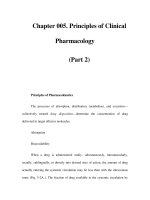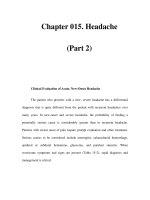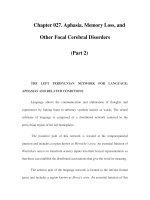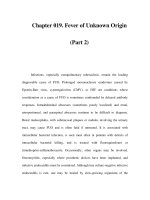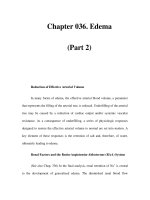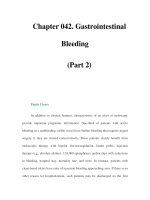Chapter 108. Hematopoietic Cell Transplantation (Part 2) ppt
Bạn đang xem bản rút gọn của tài liệu. Xem và tải ngay bản đầy đủ của tài liệu tại đây (14.91 KB, 5 trang )
Chapter 108. Hematopoietic
Cell Transplantation
(Part 2)
With current techniques, the risk of graft rejection is 1–3%, and the risk of
severe, life-threatening acute GVHD is ~15% following transplantation between
HLA-identical siblings. The incidence of graft rejection and GVHD increases
progressively with the use of family member donors mismatched for one, two, or
three antigens. While survival following a one-antigen mismatched transplant is
not markedly altered, survival following two- or three-antigen mismatched
transplants is significantly reduced, and such transplants should be performed only
as part of clinical trials.
Since the formation of the National Marrow Donor Program, it has become
possible to identify HLA-matched unrelated donors for many patients. The genes
encoding HLA antigens are highly polymorphic, and thus the odds of any two
unrelated individuals being HLA-identical are extremely low, somewhat less than
1 in 10,000. However, by identifying and typing >7 million volunteer donors,
HLA-matched donors can now be found for ~50% of patients for whom a search is
initiated. It takes, on average, 3–4 months to complete a search and schedule and
initiate an unrelated donor transplant. Results so far suggest that GVHD is
somewhat increased and survival somewhat poorer with such donors than with
HLA-matched siblings.
Autologous transplantation involves the removal and storage of the
patient's own stem cells with subsequent reinfusion after the patient receives high-
dose myeloablative therapy. Unlike allogeneic transplantation, there is no risk of
GVHD or graft rejection with autologous transplantation. On the other hand,
autologous transplantation lacks a graft-versus-tumor (GVT) effect, and the
autologous stem cell product can be contaminated with tumor cells that could lead
to relapse. A variety of techniques have been developed to "purge" autologous
products of tumor cells. Some use antibodies directed at tumor-associated antigens
plus complement, antibodies linked to toxins, or antibodies conjugated to
immunomagnetic beads. In vitro incubation with certain chemotherapeutic agents
such as 4-hydroperoxycyclophosphamide and long-term culture of bone marrow
have also been shown to diminish tumor cell numbers in stem cell products.
Another technique is positive selection of stem cells using antibodies to CD34,
with subsequent column adherence or flow techniques to select normal stem cells
while leaving tumor cells behind. All these approaches can reduce the number of
tumor cells from 1000- to 10,000-fold and are clinically feasible; however, no
prospective randomized trials have yet shown that any of these approaches results
in a decrease in relapse rates or improvements in disease-free or overall survival.
Bone marrow aspirated from the posterior and anterior iliac crests has
traditionally been the source of hematopoietic stem cells for transplantation.
Typically, anywhere from 1.5 to 5 x 10
8
nucleated marrow cells per kilogram are
collected for allogeneic transplantation. Several studies have found improved
survival in the settings of both matched sibling and unrelated transplantation by
transplanting higher numbers of bone marrow cells.
Hematopoietic stem cells circulate in the peripheral blood but in very low
concentrations. Following the administration of certain hematopoietic growth
factors, including granulocyte colony-stimulating factor (G-CSF) or granulocyte-
macrophage colony-stimulating factor (GM-CSF), and during recovery from
intensive chemotherapy, the concentration of hematopoietic progenitor cells in
blood, as measured either by colony-forming units or expression of the CD34
antigen, increases markedly. This has made it possible to harvest adequate
numbers of stem cells from the peripheral blood for transplantation. Donors are
typically treated with 4 or 5 days of hematopoietic growth factor, following which
stem cells are collected in one or two 4-h pheresis sessions. In the autologous
setting, transplantation of >2.5 x 10
6
CD34 cells per kilogram, a number easily
collected in most circumstances, leads to rapid and sustained engraftment in
virtually all cases. Compared to the use of autologous marrow, use of peripheral
blood stem cells results in more rapid hematopoietic recovery, with granulocytes
recovering to 500/µL by day 12 and platelets recovering to 20,000/µL by day 14.
While this more rapid recovery diminishes the morbidity of transplantation, no
studies show improved survival.
Hesitation in studying the use of peripheral blood stem cells for allogeneic
transplantation was because peripheral blood stem cell products contain as much
as one log more T cells than are contained in the typical marrow harvest; in animal
models, the incidence of GVHD is related to the number of T cells transplanted.
Nonetheless, clinical trials have shown that the use of growth factor–mobilized
peripheral blood stem cells from HLA-matched family members leads to faster
engraftment without an increase in acute GVHD. Chronic GVHD may be
increased with peripheral blood stem cells, but in trials conducted so far, this has
been more than balanced by reductions in relapse rates and nonrelapse mortality,
with the use of peripheral blood stem cells resulting in improved overall survival.
Umbilical cord blood contains a high concentration of hematopoietic
progenitor cells, allowing for its use as a source of stem cells for transplantation.
Cord blood transplantation from family members has been explored in the setting
where the immediate need for transplantation precludes waiting the 9 or so months
generally required for the baby to mature to the point of donating marrow. Use of
cord blood results in slower engraftment and peripheral count recovery than seen
with marrow but a low incidence of GVHD, perhaps reflecting the low number of
T cells in cord blood. Several banks have been developed to harvest and store cord
blood for possible transplantation to unrelated patients from material that would
otherwise be discarded. A summary of the first 562 unrelated cord blood
transplants, facilitated by the New York Blood Center, reported engraftment in
~85% of patients but at a slower pace than seen with marrow. Severe GVHD was
seen in 23% of patients. The risk of graft failure was related to the dose of cord
blood cells per kilogram infused. The low cell content of most cord blood
collections has limited the use of this approach for adult patients.

